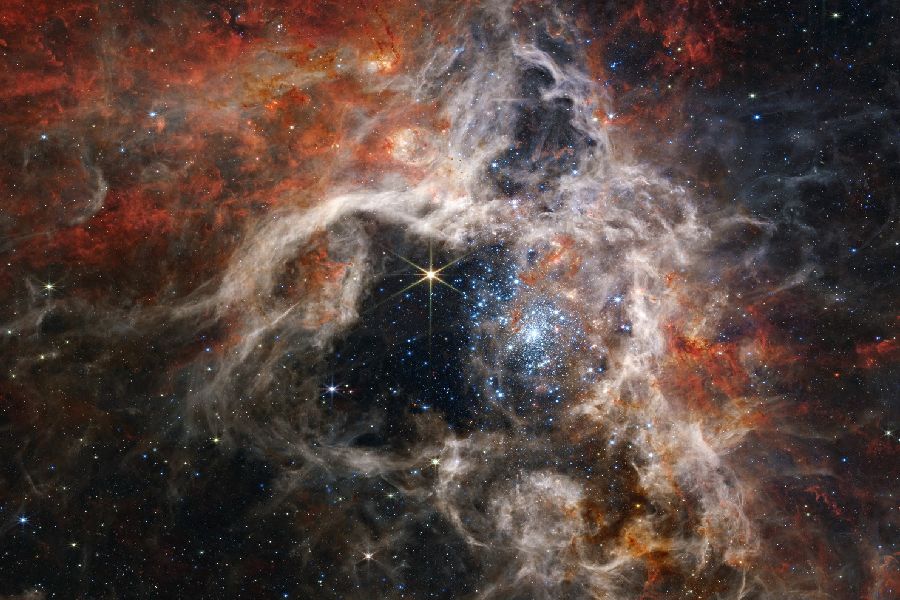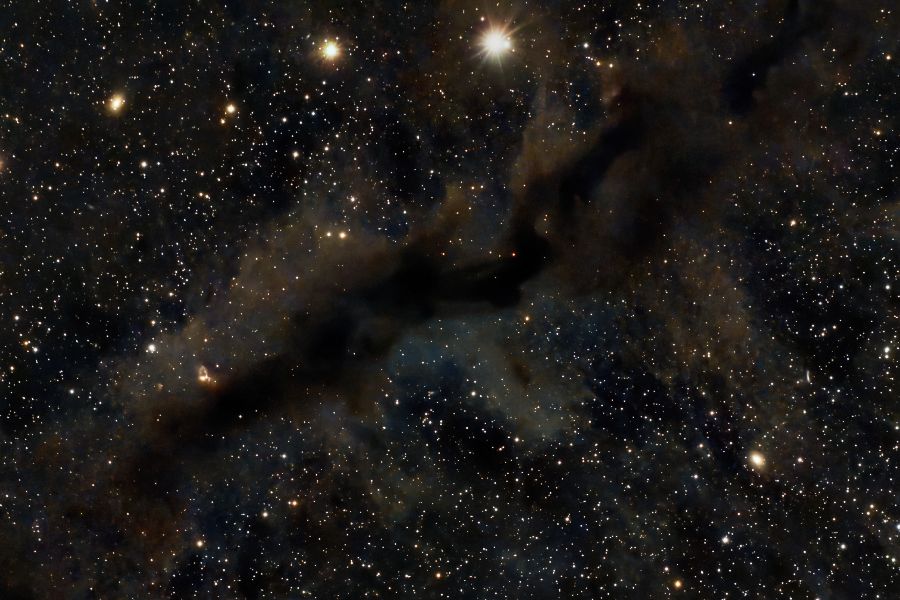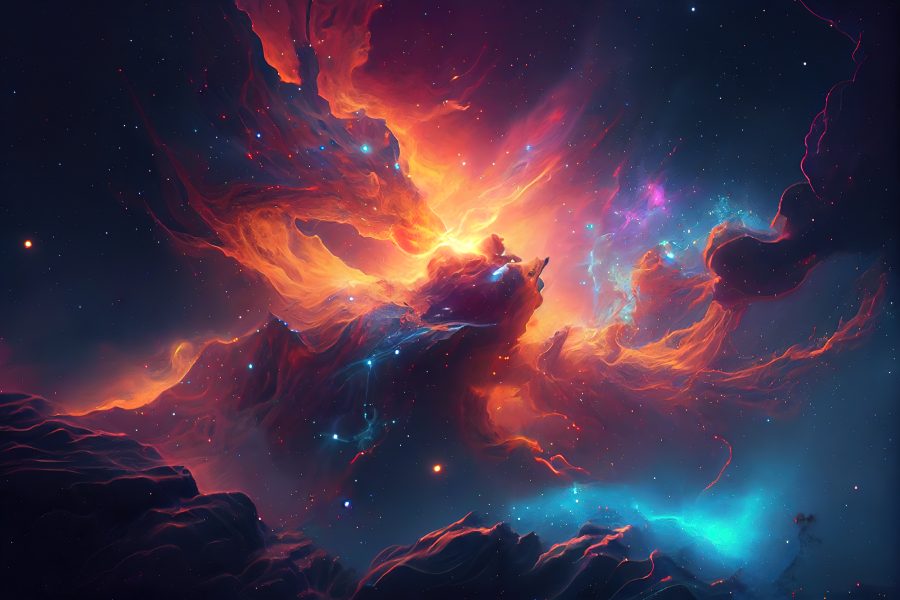Among the most spectacular sights in our universe are the cosmic clouds of gas and dust called nebulae. These stellar nurseries and galleries of galactic artwork illuminate the darkness of deep space with their vibrant colors and intricate shapes. But what is a nebula? What are nebulae made of?
Read on to uncover the secrets of nebulae, those transitory yet wondrous waypoints in the stellar life cycle. We’ll study their role in birthing stars and planets while conveying these celestial spectacles’ green and crimson grandeur. Perhaps even gaining a new appreciation for our solar system’s gaseous origins.

What Is a Nebula?
A nebula is an enormous cloud of gas and space dust between stars and stellar systems. But how are nebulae formed? Nebulae usually comprise hydrogen, plasma, dust, and other ionized gases.
They serve as stellar nurseries, forming new stars from collapsing nebula gases. Alternatively, they function as stellar graveyards, where the ejected material from dying stars is suspended. Also, nebulae display a variety of shapes and vibrant colors from the radiant gases they contain.
Categories of Nebulae
Reflection nebulae
Reflection nebulae appear illuminated because they effectively reflect light from nearby stars outward toward us. They contain gases and large dust grains acting as cosmic mirrors scattering visible and infrared light. This gives reflection nebulae bluish, dreamy diffused colors and foggy textures.
Famous examples visible include the Witch Head Nebula, and the Pleiades star cluster enveloped in a subtle blue haze. Unlike other nebula types, reflection nebulae lack significant internal heat sources and redirect existing starlight across their boundaries into intriguing patterns, as seen from Earth.
Emission nebulae
Emission nebulae glow vibrantly across multiple wavelengths from infrared to X-ray by re-emitting intense radiation energy from extremely hot young stars born within them.
Enormous molecular clouds of primarily hydrogen gas collapse under gravity into compact cores. The process initiates nuclear fusion, making new stars shine brilliantly within the stellar nursery nebula.
This fierce stellar radiation excites electrons orbiting hydrogen atoms contained inside, causing them to gain energy. Later, they emit the surplus light particles at specific wavelengths when relaxing their orbits again.
So, depending on elemental composition, different emission nebulae can glow red from excited hydrogen or blue-green from energetic oxygen atoms present.
Dark nebulae
In contrast to glowing emission stellar nurseries, dark nebulae appear as cold, opaque silhouettes against space. This is because they contain extremely dense interstellar clouds of gas and dust, blocking background starlight or nebula radiation from penetrating them.
Sometimes called absorption nebulae, they exemplify regions in space where new stars and planets are still slowly coalescing together from primordial ingredients. This occurs before radiation pressure from stellar ignition causes any visible luminosity.
The Snake Nebula offers an example of curved lanes of thick dark gases snaking across brighter neighboring stellar regions. Rather than being empty, though, dark nebulae harbor emerging worlds yet to be illuminated.

Types of Nebulae
Planetary nebulae
Planetary nebulae represent the ejected outer layers of dying stars similar in mass to our Sun. After passing through the red giant phase, aging stars shed their gaseous envelopes to form intricate planetary nebulae shapes illuminated as the core white dwarf star winds up unveiled.
Hence, beautiful symmetry emerges from spheres of stellar shrouds like the Dumbbell Nebula. This celestial beauty will gradually fade over tens of thousands of years as they merge into the interstellar medium.
Supernova remnants
When massive stars exhaust their nuclear fuel, colossal explosions called supernovae occur. These explosions outshine entire galaxies temporarily while dispersing the stellar cores’ newly forged heavy elements outward at extreme velocities.
What remains are scattering expanding shells of material that collide with surrounding interstellar gas to trigger glowing emission nebulae and accelerate cosmic rays to affect star formation nearby. The Crab Nebula’s delicate tendrils evidence the complexity following catastrophic stellar collapse.
HII regions
HII regions constitute wide emission nebulae zones ionized by radiation flooding from extremely massive hot young stars still cocooned within stellar nursery clouds. Nascent blue supergiant stars will only live for a few million years before self-destruction.
Yet in death, they seed the surrounding nebula to birth succeeding generations. Photographs of the Lagoon and Trifid reveal the magnificent chaos inside stellar hatcheries like these huge star-birthing HII regions.
Characteristics of Nebulae
Composition
Nebulae consist predominantly of hydrogen, around 90% by mass, and helium, making up most of the remainder. Trace elements like oxygen, carbon, and iron also get detected, enriching any fledgling star systems later coalescing. This nebular composition directly affects emerging stellar chemistry and any potential planets able to form around them.
Structure
Ethereal nebula shapes span from long interstellar filaments like the Snake Nebula to dense, compact globules and sheets encompassing hundreds of light years, sculpted by winds and radiation gusting from nearby stellar explosions. Then, gravity concentrates pockets within these vibrant clouds, allowing new stars to burst forth surrounded by glowing nebulae rendered in our telescopes.
Appearance
What do nebulae look like? Nebulae showcase incredibly diverse colors, from crimson hydrogen clouds to emerald oxygen tones, revealing their elemental identities through spectroscopy.
Structural details emerge via ultraviolet and infrared imaging tuned to specific nebula signatures. This exposes intimate stellar nurseries normally shrouded from direct optical sight.
Age
Nebulae vary from newly birthed dust beds hundreds of degrees warmer than the cosmic microwave background ringing the Big Bang. They also include ancient, slowly cooling reddish shells from stars that perished eons ago. Moreover, complex filamentary patterns disclose their formation story imprinted long ago before scattering into the galactic night again.

Conclusion
What is a nebula? As we have seen, nebulae represent colorful signposts in space that showcase the life cycles of stars across the cosmos. From dark clouds harboring newly forming worlds to bright glowing gases ejected by dying stars, nebulae demonstrate stellar life cycles.
They show how stars give birth to new generations, even in destruction. The vivid nebula views reveal the constant interplay of creation and destruction at work as new stars coalesce from old ones.
We hope this exploration illuminated that nebulae constitute far more than ghostly apparitions in the galaxy’s depths. Analyzing their composition, behavior and transformations grants profound insights into the interwoven epochs of planetary congelation and energetic forces in seeding new suns.
